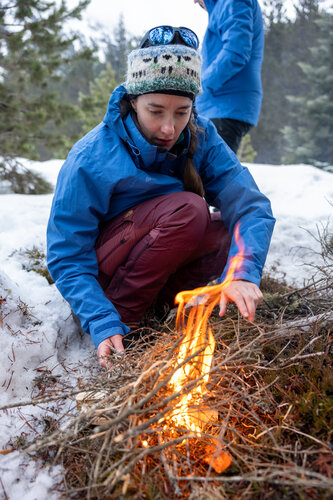ESA astronaut candidate Rosemary Coogan from the UK mastering fire and frost during winter survival training in the snowy mountains of the Spanish Pyrenees as part of her basic astronaut training.
Next to water survival training, winter survival is an important part of astronaut training, addressing the possibility of a spacecraft landing in remote or unexpected locations. Throughout this training course, astronaut candidates engage in a wide range of activities aimed at learning essential survival skills. These include learning how to create fires in the wilderness, effectively manage cold-related injuries and hypothermia, construct makeshift stretchers, build snow shelters, and endure nights in sub-zero temperatures.
Additionally, the candidates practice navigating without relying on electronic devices like a GPS, communicating efficiently during emergencies, signalling for rescue, and preparing for potential helicopter rescue.
The training also provides an opportunity for candidates to develop leadership and teamwork capabilities, with them rotating through various roles within simulated scenarios guided by instructors.
“It was a really special experience - learning skills that may help us survive one day, with a strong emphasis on teamwork, getting to know how we react in difficult situations we've never encountered before, and bonding as a group”, says Rosemary.
The group included ESA astronaut candidates Sophie Adenot, Rosemary Coogan, Pablo Álvarez Fernández, Raphaël Liégeois, and Marco Sieber, ESA member of the reserve John McFall, alongside Katherine Bennell-Pegg from the Australian Space Agency. The candidates are currently undergoing basic astronaut training and familiarisation primarily conducted at ESA’s European Astronaut Centre (EAC) in Cologne, Germany.
The one-year training provides an overall familiarisation and training in various areas, such as spacecraft systems, spacewalking, flight engineering, robotics and life support systems. They go through survival and medical training before receiving ESA astronaut certification in the spring of this year.
After certification, they will move on to the next phases of pre-assignment and mission-specific training, paving the way for future missions to the International Space Station and beyond.



 Image:
ESA astronaut candidate Rosemary Coogan lighting a fire during winter survival training in the snowy mountains of the Spanish Pyrenees as part of her basic astronaut training.
Image:
ESA astronaut candidate Rosemary Coogan lighting a fire during winter survival training in the snowy mountains of the Spanish Pyrenees as part of her basic astronaut training.